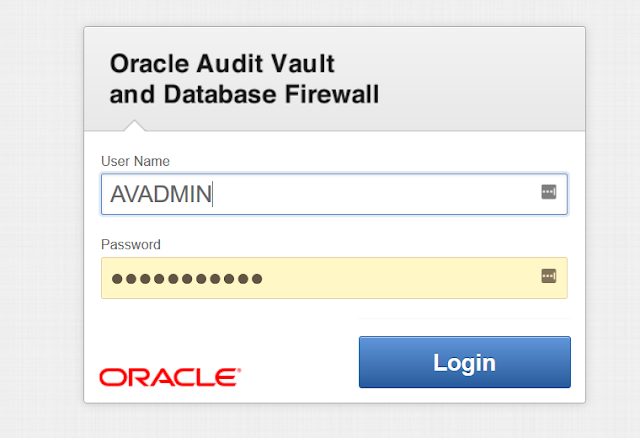IP of the Primary Audit Vault Server: 192.168.56.20
IP of the Secondary Audit Vault Server: 192.168.56.40
Configuring the Secondary Oracle Audit Vault Server
Login in to Oracle Database Firewall web console of the Primary Oracle Audit Vault Server:
Copy the certificate.
In another browser window, log in to Secondary Audit Vault Server as a super administrator.
In the Secondary Audit Vault Server web console, click the "Settings" tab.
From the "System" menu, select "High Availability".
Click in “Configure this server as: Secondary Server”
In the Peer System IP Address field, enter the IP address of Server1.
In the Peer System Certificate field, paste the certificate of Server1.
Click Save.
Configuring the Primary Oracle Audit Vault Server
Log in to Secondary Audit Vault Server as an administrator.
In the Settings tab of Server1, from the Security menu, click Certificate.
Copy the certificate.
In another browser window, log in to Primary Audit Vault Server web console as a super administrator.
In the Primary Audit Vault web console, click the "Settings" tab.
From the "System" menu, select "High Availability".
Select the checkbox "Configure this system as: Primary server".
In the Peer System IP Address field, enter the IP address of Secondary Audit Vault Server.
In the Peer System Certificate field, paste the certificate of Secondary Audit Vault Server.
Click in "Initiate Pairing"
A message will appear asking if you are sure. Click in "OK".
A message will appear saying the configuration will be completed in around 10 minutes:
During the Pairing Process I took a look into the Primary
Database to understand how the High Availability configuration is done. First I
saw that the Primary database was in “No Archive log” mode.
SQL> archive log list
Database log mode No Archive Mode
Automatic archival Disabled
Archive destination USE_DB_RECOVERY_FILE_DEST
Oldest online log sequence 6
Current log sequence 8
SQL>
SQL>
[oracle@avs08002778ad2b ~]$
dgmgrl /
DGMGRL for Linux: Version
12.1.0.2.0 - 64bit Production
Copyright (c) 2000, 2013,
Oracle. All rights reserved.
Welcome to DGMGRL, type
"help" for information.
Connected as SYSDG.
DGMGRL> show configuration;
ORA-16525: The Oracle Data
Guard broker is not yet available.
Configuration details cannot be
determined by DGMGRL
DGMGRL> exit
But after some minutes I saw the Primary Database was working
in Archive Log Mode.
SQL> archive log list
Database log mode Archive Mode
Automatic archival Enabled
Archive destination USE_DB_RECOVERY_FILE_DEST
Oldest online log sequence 7
Next log sequence to
archive 9
Current log sequence 9
SQL>
That made me think that the High Availability configuration for
Oracle Audit Vault servers is done with Oracle Data Guard, then I decided to
check:
DGMGRL> show configuration;
Configuration - DBFWDB
Protection Mode: MaxPerformance
Members:
DBFWDB_HA1 - Primary database
DBFWDB_HA2 - Physical standby database
Fast-Start Failover: DISABLED
Configuration Status:
DISABLED
DGMGRL>
And after some minutes the Data Guard Configuration was working
fine:
DGMGRL> show configuration;
Configuration - DBFWDB
Protection Mode: MaxPerformance
Members:
DBFWDB_HA1 - Primary database
DBFWDB_HA2 - (*) Physical standby database
Fast-Start Failover: ENABLED
Configuration Status:
SUCCESS (status updated 13 seconds ago)
DGMGRL>
There is another nice script provided by oracle to check the
status of the Audit Vault Server High Availability configuration:
[oracle@avs08002778ad2b ~]$
/usr/local/dbfw/bin/setup_ha.rb --status
HA mode: PRIMARY
HA server 1:
192.168.56.20
HA server 2:
192.168.56.40
Unique database name:
DBFWDB_HA1
Current database role: PRIMARY
Data guard broker: ENABLED
Data guard observer: YES
Current log mode: ARCHIVELOG
Logging forced: YES
Flashback mode: YES
Current open mode: READ WRITE
Switchover status: TO STANDBY
Automatic failover: ENABLED
Failover status: TARGET UNDER LAG LIMIT
Missing listener services: NONE
Archive destination: ENABLE
Recovery mode: MANAGED REAL TIME APPLY
FRA size: 47,244,640,256
FRA used: 2,189,426,688
FRA reclaimable: 1,113,587,712
FRA available: 46,168,801,280
Gap status: NO GAP
Archived sequence: 13
Applied sequence: 12
Apply lag: 0:00:21
[oracle@avs08002778ad2b ~]$
[oracle@avs08002778ad2b ~]$
/usr/local/dbfw/bin/setup_ha.rb -h
Usage:
/usr/local/dbfw/bin/setup_ha.rb configure [options]
-v, --verbose Verbose mode
-R, --randompassword Create random SYS password
--syslog Send the output to the
syslog instead of stdout
--foreground Run all operations in
foreground
--standby Configure standby database
(internal)
--configure Configure HA on primary and
standby systems
--unconfigure Unconfigure existing HA system
--synchronize Synchronize data not stored in
the database
--switchover Swap primary and standby roles
--post_switchover Execute actions on new primary
after the database switchover completes (internal)
--post_primary_upgrade operations on standby after primary
upgrade(Internal)
--database_key_info Collect database key info (internal)
--system_properties Collect system properties (internal)
--storage_configuration Export storage configuration (internal)
--failover Failover to standby database
--disable_failover Disable automatic failover
--enable_failover Enable automatic failover if it was
previously disabled. The automatic failover is enabled by default.
--process_status Return the status of setup_ha
process as exit code
--dg_status Print Data Guard Broker
status
--handle_role_change Handle role change
--status Print HA configuration
status
--ha_role Return HA role as exit code
--partner_ha_role Return partner HA role as exit code
--check_cfg Check the AVS HA
configuration (internal)
--correct_ha Check the AVS HA settings and
correct if necessary (internal)
--test_settings Test if the system settings are
correctly configured for HA
--update_partner_ip IP Update the configuration file with the
new IP of the other AVS
-h, --help Show this message
[oracle@avs08002778ad2b ~]$
After to wait some minutes. The High Availability was completed, we can check the current status in the web console of the primary
Oracle Audit Vault Server. If you try to access the web console of Secondary
Oracle Audit Vault server you will be redirected automatically to the primary
one.
For Failover, take in consideration the following:
When failover is enabled, during normal operation, the system periodically checks the availability of the primary Audit Vault Server in the resilient pair.
Note the following scenarios:
- If the primary Audit Vault Server becomes unavailable, the system automatically fails over to the secondary Audit Vault Server after a 10 minute delay. The delay prevents a failover due to a reboot of the primary server.
DGMGRL> show configuration;
Configuration - DBFWDB
Protection Mode: MaxPerformance
Members:
DBFWDB_HA2 - Primary database
Warning: ORA-16829: fast-start failover configuration is lagging
DBFWDB_HA1 - (*) Physical standby database (disabled)
ORA-16661: the standby database needs to be reinstated
Fast-Start Failover: ENABLED
Configuration Status:
WARNING (status updated 26 seconds ago)
- If the primary Audit Vault Server is manually shut down, the failover process is not triggered. If you bring the primary Audit Vault Server back online, then it continues in high availability mode.
- If the primary Audit Vault Server is manually shut down and reinstalled or replaced with another server, then you must perform the following procedure:
- Manually failover the current standby server by issuing the following command as the oracle user: /usr/local/dbfw/bin/setup_ha.rb --failover
- Then log in to the Audit Vault console as the super administrative user so that you can unpair the two servers.
- Select Settings, and then select High Availability.
- In the High Availability status page, click the Unpair button.
- Copy the new certificates between the two Audit Vault servers.
- Initiate the high availability setup again by clicking the Initiate Pairing button.
- In the event of a failover, the secondary server becomes the new primary Audit Vault Server. You must do the following to configure this primary server, and repeat the high availability pairing:
- Log in to the Audit Vault Server console as a super administrator.
- Click on the Settings tab.
- Select Settings, and then select High Availability.
- In the High Availability Status page, unpair the new primary server to convert it to a standalone server by clicking on the Unpair button.
- On the standalone server, configure the network and services settings (for example DNS settings).
- On the standalone server, manually mount any remote filesystems (NFS shares) defined as archive locations, using this AVCLI command: ALTER REMOTE FILESYSTEM filesystem_name MOUNT
- Disconnect the failed server and replace it. The replacement server can now be configured as the new secondary server.
- Follow the configuration steps again to pair the two Audit Vault Servers.












HI
ResponderEliminarHow the database data gets copied from primary avdf database to secondary avdf database?.
In my case we have 2TB of primary AVDF database. Now we are configuring the HA.
In HA config setup we have to install fresh AVDF on secondary server which will create the plain database as well. THen do we need to increase tablespace size and make the space same as the Primary AVDF tablespace size before doing the HA configuration?
After manually Unpair AVDF HA configuration how can we reconfigure HA again with same system because after unpair primary server shows standalone but secondary server (old standby server) shows standby
ResponderEliminar